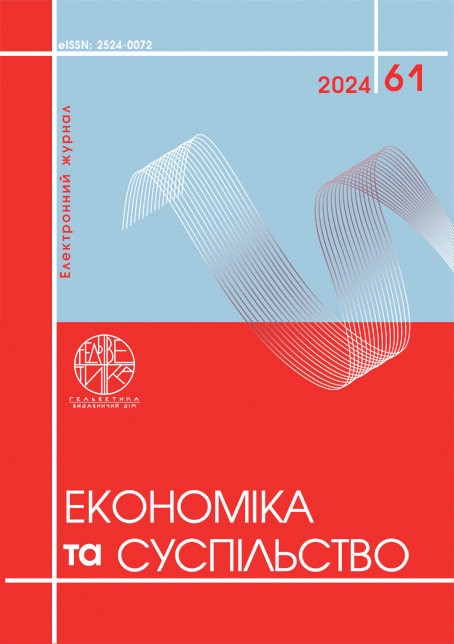INFLUENTIAL FACTORS ON THE OPTIMIZATION OF RESOURCE FLOWS FOR ENTERPRISES IN THE CONDITIONS OF NETWORK TRADE DEVELOPMENT
Abstract
This article is dedicated to identifying and analyzing the factors influencing the optimization of resource flows for enterprises in the network trade sector. Based on the examination of researchers' positions, analysis of enterprise data, and the results of conducted expert surveys among business leaders, it has been revealed that when making optimization decisions in managing resource flows amidst network trade development, it is important to consider factors such as technological innovations, supply chain flexibility, supply chain resilience, environmental sustainability, inventory management rationality, transportation system optimality, digital integration, multichannel distribution, packaging innovations, human resource development, strategic planning, and customer orientation. Examples from global and Ukrainian companies like Amazon, Netflix, METRO Cash & Carry Ukraine, Rozetka, SoftServe, and others confirm that consideration of these factors and adept adaptation to market changes are key to achieving success. Companies resort to data analysis, implement innovations, optimize supply chains, and prioritize customer needs to ensure sustainable development and enhance competitiveness. It is argued that managing resource flows in network trade conditions requires a comprehensive approach and continuous updating of strategies considering the mentioned factors. Optimizing these resource flows contributes to increased efficiency, profitability, and resilience of enterprises, enabling them to occupy a significant position in the network trade market. It is substantiated that the success of enterprises in the network trade sector is not limited to technical aspects alone but also requires flexibility, adaptability, and a capability for continuous improvement. Optimization of resource flows becomes a key competitive advantage in a world where changes occur dynamically, and consumers have high demands. Additionally, it is necessary to note that successful enterprises consider not only their own needs and strategies but also become part of a larger ecosystem, collaborating with partners and considering the impact on the environment.
References
Бондаренко О. С. Фінансові ресурси та фінансові потоки: сучасна теорія і практика управління. Інвестиції: практика та досвід. 2017. № 4. С. 25–28. URL: http://www.investplan.com.ua/pdf/4_2017/7.pdf .
Злотнік М. Управління зворотними потоками в умовах циркулярної економіки. Економіка та суспільство. 2021. №34. URL: https://doi.org/10.32782/2524-0072/2021-34-16 .
Мельникова Н.В., Янченко Н.В. Показники оцінки прямого і зворотного матеріальних потоків промислового підприємства. Проблеми та перспективи розвитку підприємництва. 2018. № 20. DOI: https://doi.org/10.30977/PPB.2226-8820.2018.20.0.98
Яременко О. Ф. Митна логістика: поняття, функції, особливості. Вісник Хмельницького національного університету. 2021. Т. 1. № 6. С. 32–36. DOI: https://www.doi.org/10.31891/2307-5740-2021-300-6-5 .
Bondarenko O. S. (2017) Finansovi resursy ta finansovi potoky: suchasna teoriia i praktyka upravlinnia [Financial resources and financial flows: modern theory and practice management]. Investytsii: praktyka ta dosvid, vol. 4, pp. 25–28. Available at: http://www.investplan.com.ua/pdf/4_2017/7.pdf .
Zlotnik M. (2021) Upravlinnia zvorotnymy potokamy v umovakh tsyrkuliarnoi ekonomiky [Reverse flow management in a circular economy]. Ekonomika ta suspilstvo - Economy and Society, vol. 34. DOI: https://doi.org/10.32782/2524-0072/2021-34-16 .
Melnykova N.V., Yanchenko N.V. (2018) Pokaznyky otsinky priamoho i zvorotnoho materialnykh potokiv promyslovoho pidpryiemstva [The indicators of assessing the direct and reverse material flows of industrial enterprise]. Problemy ta perspektyvy rozvytku pidpryiemnytstva. vol. 20. Available at: https://doi.org/10.30977/PPB.2226-8820.2018.20.0.98
Iaremenko O. F. (2021) Mytna lohistyka: poniattia, funktsii, osoblyvosti [Customs logistics: concepts, functions, features]. Visnyk Khmelnytskoho natsionalnoho universytetu, vol. 1. № 6, pp. 32–36. DOI: https://www.doi.org/10.31891/2307-5740-2021-300-6-5 .

This work is licensed under a Creative Commons Attribution 4.0 International License.


